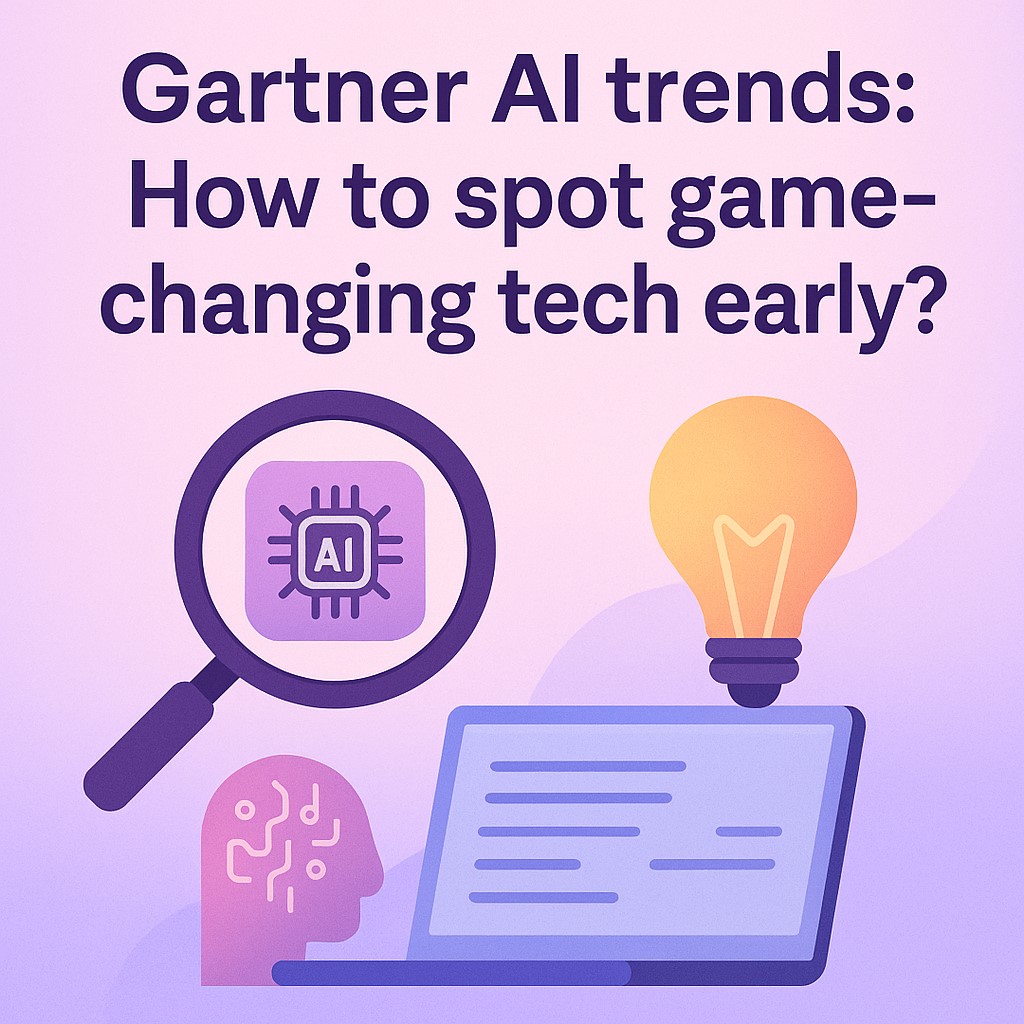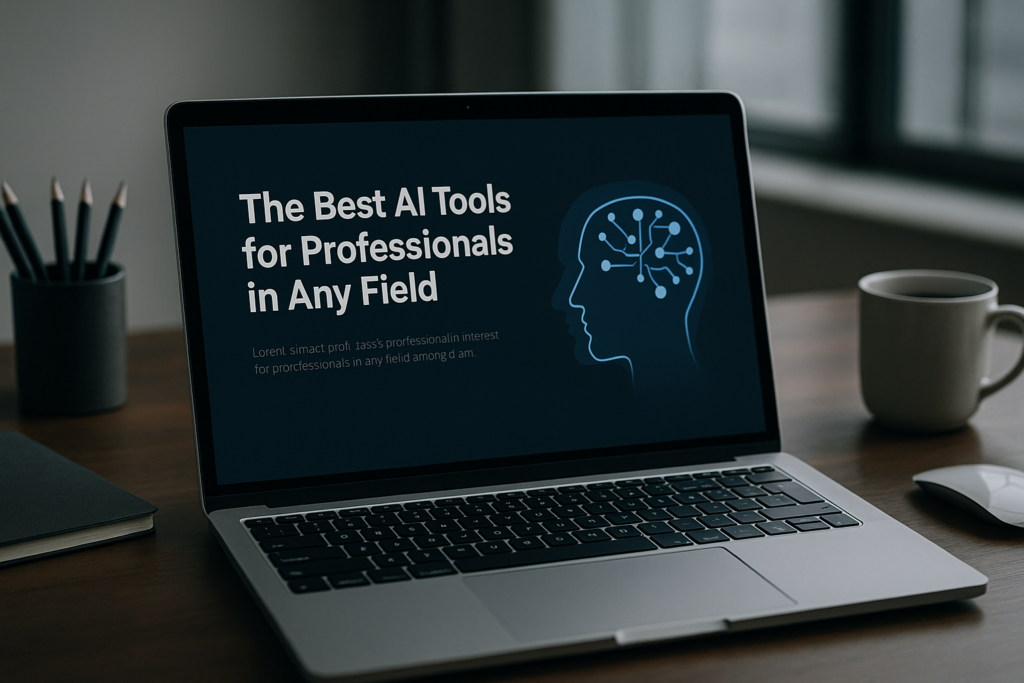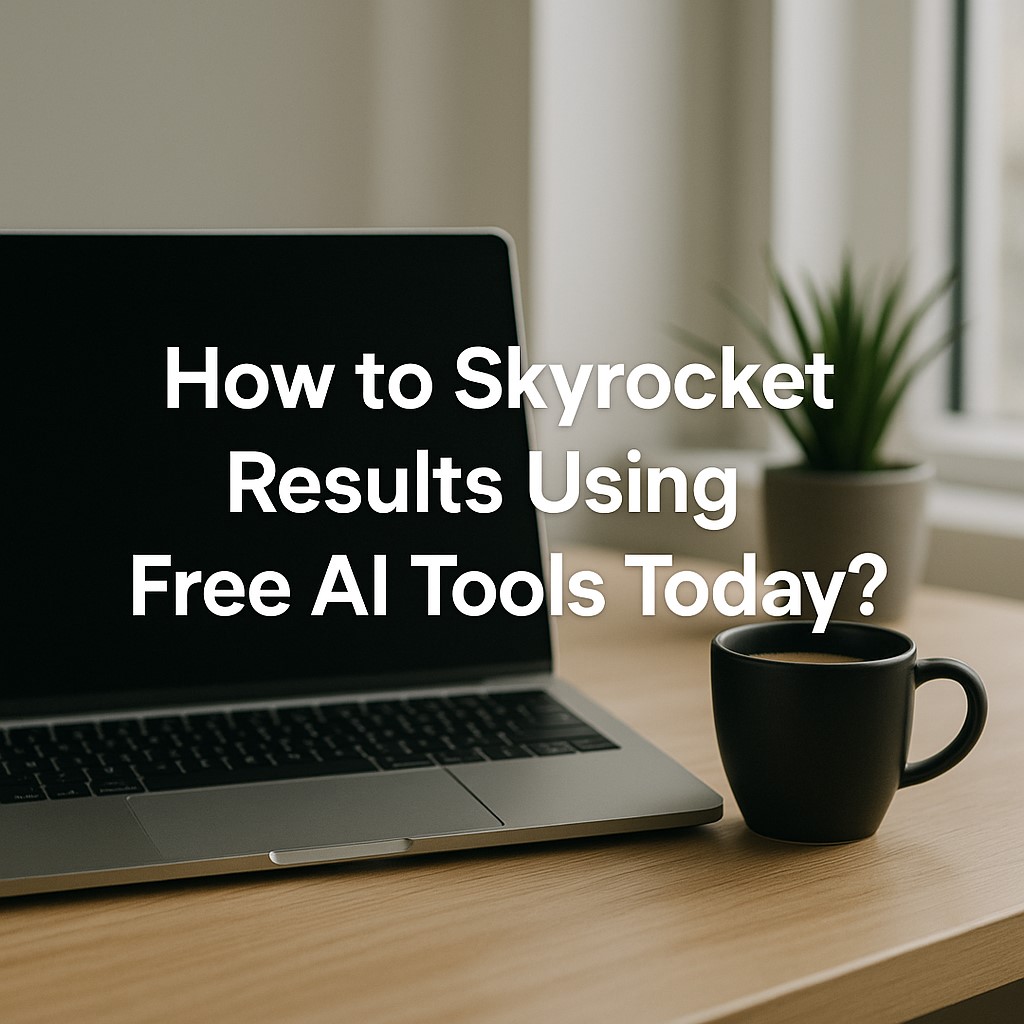Curious about where AI is heading next? Gartner AI trends reveal the coolest tech shifts students should watch if they want to stay ahead.
Technology changes fast. And if you want to keep up, you need to know what’s coming next. That’s where Gartner AI trends come in.
Gartner is a company that studies big tech changes. Every year, it shares reports on what’s new and important in AI. These reports are called Gartner AI trends. They show how AI tools are being used by businesses and where things are headed.
So why should students care? Because these trends affect the future of jobs, learning, and even the apps you already use. Gartner AI trends aren’t just predictions—they’re signs of what’s already happening. From smarter chatbots to AI that writes code, these trends are shaping real tools in real time.
When you follow Gartner AI trends, you learn more than just facts. You get a sneak peek into what skills you’ll need, what tech companies are investing in, and what innovations might pop up next in school, work, or your favorite games. It’s like getting early access to the future.
Let’s break it down and see what these trends really mean—and why they matter to you.
Table of content
- Gartner AI trends vs Gartner Hype Cycle 2025
- Top Gartner AI trends in emerging technologies
- How Gartner AI trends shape machine learning today?
- Gartner AI trends and predictions for 2025
- Key Gartner AI trends in tech for businesses
- Insights from the Gartner AI trends adoption report
- Gartner AI trends in strategic technologies
- Real Gartner AI trends in enterprise tech
- FAQs: Gartner AI trends
- Final thoughts
Gartner AI trends vs Gartner Hype Cycle 2025
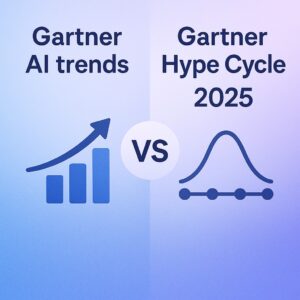
What’s the difference and why it matters? If you’re trying to understand what’s happening in the world of AI, you’ve probably come across two big terms: Gartner AI trends and the Gartner Hype Cycle 2025. These sound similar, but they actually show different things. Knowing how they work—and how they’re different—can help you stay ahead in the AI game.
Gartner AI trends show what’s really working
Gartner AI trends are all about what’s happening right now in the world of artificial intelligence. These trends highlight the key technologies that companies are using and investing in. For example, generative AI, AI chatbots, and machine learning are all part of current trends. Gartner looks at how these tools are being used in real businesses, schools, and even government settings.
These trends give you a real-world view. They show how AI is solving problems, saving time, and improving productivity. So if you’re a student learning about AI or someone planning a career in tech, Gartner AI trends can point you toward the tools and skills that matter most today.
The Hype Cycle maps how AI ideas grow
The Gartner Hype Cycle 2025 is a bit different. It tracks how new technologies move through five stages—from being overhyped to actually delivering value. It usually starts with a cool new idea that gets everyone excited. That’s called the “Innovation Trigger.” But then, reality kicks in. People realize it’s not perfect. That’s the “Trough of Disillusionment.”
Eventually, the technology improves, and people figure out how to use it well. That’s when it reaches the “Plateau of Productivity.” So the Hype Cycle isn’t just about what’s trending—it’s about where an idea is on its journey to becoming useful.
For example, in 2025, the Hype Cycle might show that AI-powered coding tools are at their peak, while AI for emotion recognition is still working through early problems.
Why it smart to use both together?
The best way to understand AI right now is to use both Gartner AI trends and the Gartner Hype Cycle 2025. The trends help you focus on what’s being used today. The Hype Cycle shows you what might be important tomorrow, or what’s just getting too much hype.
By using both, you can make smarter decisions. You’ll know which skills are worth learning and which tools are ready to use now. Plus, you’ll be able to spot which AI ideas might grow into something big in the future.
If you’re curious about careers in AI, building a startup, or just love keeping up with new tech, comparing Gartner AI trends with the Hype Cycle gives you a full picture. It helps you learn, plan, and stay ahead of the curve.
Top Gartner AI trends in emerging technologies
What’s new and changing fast in the AI world? AI is growing fast, and new tools are popping up all the time. But which ones really matter? That’s where Gartner comes in. The top Gartner AI trends in emerging technologies help us see what’s gaining real attention in tech right now.
Generative AI is leading the way
Generative AI is one of the most talked-about trends. It lets computers create content—like text, images, and even music. Think of tools like ChatGPT, which can write full essays or answer questions in seconds. This tech is growing fast and is part of the top Gartner AI trends in emerging technologies because of how useful and creative it is. Students, teachers, and businesses are using it more every day.
AI at the edge is becoming smarter
Edge AI means AI that works on devices—like phones, cars, or robots—without needing the cloud. It’s faster, more private, and great for real-time actions. From smart assistants to wearable health devices, edge AI is a game-changer. That’s why it’s one of the top Gartner AI trends in emerging technologies for 2025. It helps AI become more flexible and useful in daily life.
Explainable AI is gaining importance
Sometimes, AI makes choices that are hard to understand. That’s a problem in fields like healthcare and finance. So now, there’s a push for “explainable AI.” This means creating systems that can explain their decisions in simple terms. This is one of the top Gartner AI trends in emerging technologies because people need to trust how AI works—especially when it affects real lives.
Why students should care?
Knowing these trends can help you prepare for the future. Whether you want to build apps, write code, or design tools, these AI technologies will be part of it. The top Gartner AI trends in emerging technologies show what’s rising fast—so you can learn the right skills early.
How Gartner AI trends shape machine learning today?

The link between real-world AI and smart learning modelsMachine learning is one of the biggest parts of AI. But how does it grow and improve? That’s where Gartner AI trends play a big role. These trends show what’s working, what’s changing, and where machine learning is headed.
Smarter training with real data
One of the biggest ways Gartner AI trends shape machine learning is through data. Trends like AI-driven automation and generative models are making machines learn faster. Instead of just training on simple patterns, new models learn from huge sets of real-world data. This makes them better at solving complex problems in areas like health, finance, and education.
Focus on responsible and ethical learning
Gartner AI trends also push for safer, more responsible AI. That means teaching machines to be fair, explain their choices, and avoid bias. These ideas affect how machine learning systems are built and tested. If AI is being used in schools or hospitals, it needs to be trusted. So, trends now focus on building ethical AI from the start.
Making machine learning more useful
The goal is to turn smart models into smart tools. Thanks to Gartner AI trends, machine learning is no longer just for researchers. It’s used in apps, websites, and even smart home devices. As trends highlight new uses, developers and students know where to focus their energy.
By following Gartner AI trends, you can understand how machine learning is becoming more helpful, fair, and powerful in everyday life.
Gartner AI trends and predictions for 2025
What to expect from AI in the next few years? As we move into 2025, Gartner AI trends show what’s next for AI technology. These predictions highlight where AI will have the biggest impact in the coming years. Understanding these trends helps students and professionals prepare for what’s to come.
The rise of autonomous systems
One of the key Gartner AI trends for 2025 is the growth of autonomous systems. These AI-powered machines will be able to perform tasks with little or no human input. From self-driving cars to automated factories, these systems will change industries. The trend is all about making things faster, safer, and more efficient. It’s a huge step toward AI taking on more complex tasks.
AI-powered decision making goes mainstream
Gartner AI trends also predict that more businesses and organizations will use AI for decision making. AI tools will analyze data and help people make smarter choices faster. Whether it’s deciding which products to sell or how to improve customer service, AI will guide these decisions. This trend means that machine learning and AI will be a crucial part of business operations.
Focus on AI security and trust
With AI growing quickly, security and trust are key issues. Gartner AI trends predict that in 2025, more focus will be on making AI systems secure and reliable. This includes protecting AI from hackers and making sure it operates in a fair and transparent way. As AI becomes a bigger part of everyday life, these concerns will be more important than ever.
By following Gartner AI trends, you’ll know exactly what to expect from AI in 2025. Whether you’re studying AI or looking for a career in tech, these predictions give you a roadmap for the future.
Key Gartner AI trends in tech for businesses
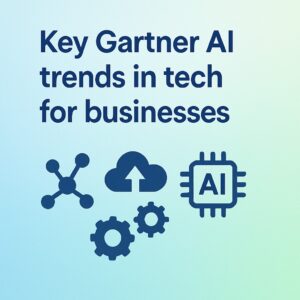
How companies use AI to grow smarter and faster? Businesses everywhere are using AI to solve problems and save time. The Gartner AI trends give us a clear picture of how companies are using this tech in smart ways. These trends show what’s working in real-world business settings—and what’s coming next.
AI for better customer experiences
One big trend is using AI to improve how businesses talk to customers. AI chatbots, voice assistants, and smart helpdesks are becoming normal. They can answer questions, fix issues, and give quick support. According to Gartner AI trends, this tech is helping companies stay available 24/7, while keeping customer service fast and friendly.
Predictive analytics helps plan ahead
Gartner AI trends also highlight predictive analytics. This means using AI to look at data and guess what might happen next. Businesses use it to forecast sales, manage stock, and even prevent problems before they happen. It’s like giving companies a smart crystal ball—and it helps them make better choices.
AI in business operations Gartner AI trends
Companies aren’t just using AI for customers. They also use it inside their offices and systems. From automating invoices to managing employees, AI handles tasks that used to take hours. Gartner AI trends say this is growing fast because it saves time and cuts down on boring, repetitive work.
Following the Gartner AI trends helps students understand how AI is changing jobs, business tools, and decision-making. If you’re planning to work in tech or business, these trends are worth watching.
Insights from the Gartner AI trends adoption report
What real-world AI use looks like today? AI isn’t just a cool idea anymore—it’s part of how businesses work every day. The Gartner AI adoption report gives us a real look at how companies are using AI right now. It also links closely to key Gartner AI trends, showing what’s working well and what still needs work.
AI is in use, but not everywhere
A lot of companies already use AI in things like customer service, automation, and data science. But not everyone is moving at the same speed. Some businesses still struggle with cost, skills, or even just trusting the tech. These issues line up with other Gartner AI trends, which show that adoption depends a lot on a company’s size, budget, and tech know-how.
Businesses want results, not just hype
The report shows that companies are focusing more on AI tools that actually help them work better. They don’t want AI just because it sounds fancy—they want it to save time and boost profits. That’s why Gartner AI trends focus on tools that work right now, not ones that might be useful someday. Businesses need tech that delivers results today.
Training is the biggest roadblock
One of the biggest problems? A lack of trained people. Many companies say they want to use more AI, but they don’t have the right talent to make it happen. AI systems need smart people to design and run them. This challenge shows up again and again in the Gartner AI trends. And for students, that means learning AI skills now could really pay off later.
So, the Gartner AI adoption report doesn’t just share numbers—it helps explain what’s really going on with AI in the business world. And it shows why understanding AI today can open big doors tomorrow.
Gartner AI trends in strategic technologies
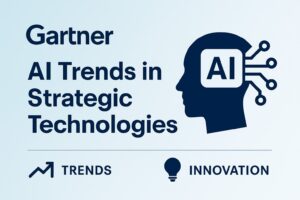
Smarter strategies start with smarter systems. Artificial intelligence (AI) isn’t just cool tech anymore—it’s part of the big picture. Today, businesses are using AI to plan long-term goals. And according to Gartner AI trends, AI is now key to building stronger, smarter strategies that actually work.
Smart tools help people work faster
Let’s take schools and colleges as an example. Many now use AI tools to manage how they talk to students, parents, and staff. These systems can feel complex, but AI helps make it easier and faster. Even at the primary level, schools are now using AI to better understand students’ emotional needs, not just test scores. That’s a big shift.
In business, it’s the same idea. AI powers tools that read big data, predict trends, and personalize services. These tools save time and help teams plan with confidence. That’s why Gartner AI trends show more companies choosing AI to make smarter decisions with less effort.
AI keeps businesses flexible
Things change fast in tech. AI helps teams stay ready. With real-time data and smart adjustments, businesses can quickly shift plans when needed. This kind of flexibility used to take days or weeks. Now it can happen in minutes. Gartner AI trends point to this agility as one of the biggest advantages AI brings to the table.
Innovation with less risk Gartner AI trends
Trying new ideas always comes with risks. But AI can test those ideas first—before they cost time or money. Businesses now use AI to run simulations, catch problems early, and improve products faster. That’s why Gartner AI trends highlight AI as a safe and smart way to innovate without losing control.
Real Gartner AI trends in enterprise tech
How AI is changing big businesses right now? AI is no longer just a cool idea—it’s something companies are using every day. According to Gartner AI trends, businesses are now depending on AI to save time, cut costs, and make smarter choices. These trends show what’s actually working in the real world, not just what’s being tested in labs.
Let’s break down a few of the most important changes happening in enterprise tech, thanks to AI.
Smarter automation is taking over boring tasks
One of the top Gartner AI trends is AI-powered automation. This means businesses are using AI tools to do tasks that used to be done by humans. Think of things like sorting emails, processing data, or tracking orders. These tasks might seem small, but they take a lot of time when done manually.
With AI, these jobs get done faster and with fewer mistakes. For example, a finance team can use AI to review invoices automatically. That means less paperwork and quicker payments. As this trend grows, many companies will rely more on automation to boost productivity and reduce human errors.
Gartner AI trends also show that automation is moving beyond simple tasks. Now, AI can handle complex workflows like managing inventory or running marketing campaigns. That’s a huge step for businesses looking to grow faster with less effort.
AI is helping with faster and smarter decisions
Another key shift in enterprise tech is how AI helps with decision-making. In the past, business leaders had to rely on gut feelings or outdated reports. But now, AI tools can scan through tons of data and spot trends quickly.
This trend—highlighted in Gartner AI trends—shows that companies are using AI to predict customer behavior, improve product design, and even make hiring choices. AI doesn’t replace human decisions, but it gives better data to work with.
Let’s say a retail company wants to know what items to restock before the holiday rush. AI can analyze sales data and forecast what customers are likely to buy. That helps managers make smarter choices—and fast.
Real-world success is pushing more AI adoption
The cool thing about Gartner AI trends is that they come from real business examples. These aren’t just ideas—they’re based on what companies are actually doing. From healthcare to banking, AI is being used to reduce risks, personalize services, and speed up customer support.
Even small businesses are starting to use AI tools because they’re becoming more affordable and easier to use. This growing access means we’ll keep seeing new trends every year.
FAQs: Gartner AI trends
What are Gartner AI trends?
Gartner AI trends are predictions and insights shared by Gartner about how AI is used in real businesses. These trends show what’s popular and what’s working in the tech world. They help companies plan for the future.
Why do companies follow these trends?
Companies trust Gartner AI trends because they come from deep research and real data. These trends help businesses know where to invest and what tools to use. It saves them time and money.
How often does Gartner update its AI trends?
Gartner updates its AI trends every year. Sometimes, they even release smaller updates during the year. This keeps the information fresh and based on the latest tech changes. Gartner AI trends often change as new tools, challenges, or ideas come up. That’s why many businesses check them regularly.
Are these trends only for big companies?
No, small businesses also use Gartner AI trends. These trends give everyone a chance to see what tools or strategies might help them grow. Even students starting their own tech projects can learn from them.
What is one new trend in 2025?
One new trend in the 2025 Gartner AI trends list is “AI-augmented development.” This means AI tools are helping developers write code faster. It saves time and improves accuracy in software creation.
How can students learn more about these trends?
Students can visit Gartner’s official site or read summaries online. Many tech blogs break down Gartner AI trends in simple words. Watching videos or listening to tech podcasts can also help.
Final thoughts
Gartner AI trends give us a clear picture of how AI is changing the business world. These trends highlight what’s working now, not just what might happen someday. From smart automation to better decision-making, they show how AI is making real impact in big and small companies.
By watching Gartner AI trends, businesses know which tools are useful and which tech is worth investing in. This helps them grow faster, work smarter, and stay ahead of their competition. Even small shifts in these trends can lead to big changes in how companies work every day.
For students, Gartner AI trends are more than just business talk—they’re a chance to understand where technology is going. If you’re studying tech, business, or even planning a startup, these trends can guide your learning and future choices.
AI isn’t just science fiction anymore. It’s shaping real jobs, tools, and ideas right now—so stay curious and keep learning.

